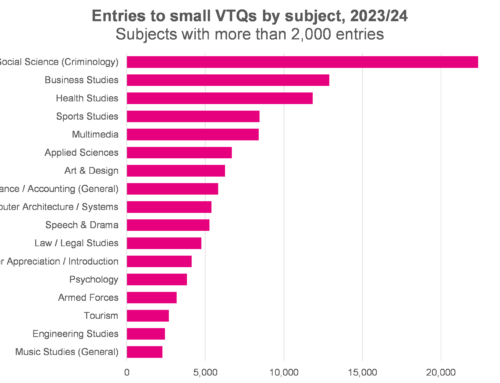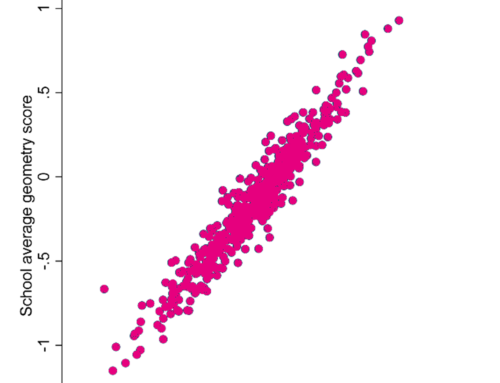Girls in physics. Boys in English. Some A-Level subjects seem to be perennially less popular with one gender than the other.[1]
In this post, we’ll use data from JCQ to take a look at the gender balance across all A-Level subjects this year. We’ll go on to explore how it’s changed over the last five years, focusing on subjects preferred by both male and female students.
The most popular A-Level subjects
It’s not exactly news that the most popular subjects for male students are very different to the most popular subjects for female students. But it does still surprise me to see just how different they are.

STEM subjects feature very strongly on the list for male students. While biology, maths and chemistry are popular with female students too, physics and computer science are much less so. The arts – notably English literature and art & design – are much more popular with female students than male, as are psychology and sociology. Male students are far more likely to opt for economics if selecting a social science.
Gender balance in 2021
The chart below shows the gender balance in all A-Level subjects this year.[2] Bear in mind that more female than male students sit A-Levels. In 2021, the overall cohort of A-Level students was 55% female. This is indicated on the chart below as a dotted line.

Media / film / TV studies, history and chemistry were all nearly exactly the same as the overall A-Level cohort in terms of gender balance, at 56%, 56% and 54% female respectively.
Arts subjects, English and the social sciences (excluding economics) were all disproportionately female. A-Levels in performing / expressive arts were the least diverse in terms of gender; 94% of students were female, although this is a subject with a very small number of entries overall – just 1,152 in 2021.
At the other end of the scale, the subjects preferred by male students tended to be those in STEM (and economics). The most disproportionately male subject, by quite some distance, was computer science at 85% male.
It’s worth noting that not all STEM subjects were disproportionately male. Biology leant the other way, with 64% female students, and chemistry was almost exactly the same as the overall population of A-Level students at 54% female.
Has gender balance improved?
Generally speaking, the subjects that were disproportionately male or female five years ago remain so now. But while there have been no dramatic reversals, there have been some smaller changes.
The chart below can be used to explore how gender balance has changed over the last five years in every A-Level subject.[3]
Changes in disproportionately male subjects
The biggest change is in design and technology. This is a subject in which entries have been in long term decline – down from 10,657 in 2017 to 8,343 this year – but female students were more likely to turn away from the subject than male students. In 2017, 39% of D&T students were female; this year, it was just 30%.
Computer science has seen a shift in the opposite direction. While it still has a very high proportion of male students, it is lower now than in 2017. The proportion of female students has increased from just 9% in 2017 to 15% this year.
Of the other subjects with a very high proportion of male students, physics and further maths have seen small increases in the proportion of female students since 2017 – from 21 to 23% in physics and from 27 to 29% in further maths – while economics has remained steady at 31%.
Chemistry was somewhat gender imbalanced in 2017, with 51% female students compared to 55% of the overall A-Level population. The proportion of female students has crept up every year since then and is now virtually the same as that of the overall A-Level cohort (54% compared to 55%).
Changes in disproportionately female subjects
There were no shifts in these subjects as large as those seen for design and technology and computer science.
However, the proportion of female students amongst those taking A-Levels in performing / expressive arts and English literature has increased since 2017, from 91 to 94% in performing / expressive arts and 75 to 77% in English literature. Both of these subjects have also seen a fall in entries over the same period.
Art and design has become slightly less disproportionately female over the last five years, falling from 76% female in 2017 to 74% this year. Psychology and sociology have both seen increased entries from both male and female students since 2017, but particularly from males, with the proportion of female students falling from 75 to 74% in psychology and 77 to 76% in sociology.
Finally, a brief mention of languages. Apart from ‘other modern languages’ – in which the proportion of female students has fallen slightly from 58% in 2017 to 57% this year – all A-Levels in languages have seen increases in their proportion of female students over the last five years. Spanish, for example, has increased from 66 to 70% female.
In summary
Gender differences in A-Level subject choice are not going away.
Many subjects are chosen much more often by one gender than the other. While some – notably computer science and chemistry – have become more gender balanced over the last five years, others have become less so.
Generally speaking, there are some promising indications for gender balance in STEM subjects. Although some subjects still have a very low percentage of girls, it does seem to be slowly increasing.
But perhaps there’s more to be done in subjects such as English, design and technology and modern foreign languages.
[1] In this post we’ve focused on a binary male / female definition of gender. As far as we’re aware, data on other gender identities is not available at present.
[2] Excluding subjects with very low entry numbers, as defined by JCQ.
[3] Excluding subjects with very low entry numbers, as defined by JCQ.









This is very useful data – it would be interesting to see the patterns for BTEC courses
Hi Anna, thanks for commenting. Indeed it would be interesting, unfortunately equivalent data on BTECs isn’t published.
It would be interesting to know if there was any difference during the Curriculum 2000 years i.e. modular A levels when it was common for students to take 4 subjects.
Another interesting point, thanks Tim! I think the answer is probably no. I’ve taken a brief look at a snapshot of data from 2005 in a few key subjects. Computer science was 9% female at the time and physics 22%. At the other end, performing / expressive arts was classified differently at the time, so I’ll ignore it, but English was 70% female and sociology 75%. In other words, it was all pretty similar to today. I think this might be a topic for a follow up post in more detail though, as might Anna’s comment above (which we may be able to answer using data from the NPD).
Really interesting piece. Here are some thoughts/wonderings I have:
1 – What if you looked at prior attainment in GCSEs. Would there be any correlation between performance and choice?
2 – What about university education? Similar distribution (particularly if we think in groups rather than subjects i.e. engineering, medicine)? I recognize this is difficult but maybe still worth a look?
3 – What is the current gender distribution in teaching? Does it match this or is it different?
4 – As was pointed out already, the BTEC data would be very interesting to compare. Why are we not collecting that?
Thanks for this, Tom. Plenty of food for thought / possible future research here. On point 3, I’m sure I remember some research from the Institute of Physics about the proportion of male / female physics grads who go into teaching, but I’ve failed to find it, annoyingly. And on 4 – it would be helpful if it was published, I agree. I’m definitely keen to do a follow up on BTECs using (non-public) data from the NPD, but it won’t be exactly equivalent and we’ll only be able to go up to 2020 as more recent data isn’t available yet.
Of the students taking Chemistry, I understand that 46% were male, and 54% were female.
I’m not sure it means that 46% of all males took Chemistry.
Is there a graph showing what % the Chemistry males were of all males, and what % the Chemistry females were of all females?
And similarly for all subjects?
Thank you.
Hi Michael, thanks for commenting! The short answer is no, we don’t have a graph showing this. Annoyingly, it’s not possible to work out the figures that you’re after with the JCQ data that we used for this post, because they don’t actually publish data on the total number of pupils who took A-Levels, only on the total number of entries.
But I’ve dug out some public DfE data, which tells us that 119,689 male and 147,521 female students took A-Levels at the end of KS5 in 2021. Of these, 23,659 male and 28,036 female students took chemistry. So 19.8% of male and 19.0% of female A-Level students took chemistry in 2021.
You can work out similar for other subjects using the DfE data from: https://explore-education-statistics.service.gov.uk/data-catalogue/a-level-and-other-16-to-18-results/2020-21 – select the option to download ‘Entries and Results – A level by subject and student characteristics (end of 16-18 study)’.
Thank you, Natasha, for your quick and detailed response. I am most grateful.
Hi Natasha. I can now carry out the calculations for England. I would like to acknowledge the source stating 119,689 males and 147,521 females in England. I would be most grateful if you could point me to the DfE source. Thank you.
Hello again. The figures are from the DfE’s ‘A level and other 16 to 18 results’, 2021.